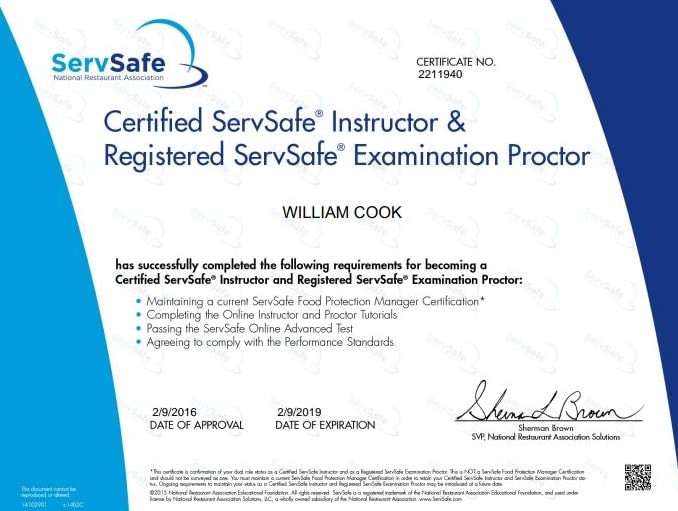Comprehending the Role of a ServSafe Food Handler in Ensuring Food Safety Criteria
Comprehending the Role of a ServSafe Food Handler in Ensuring Food Safety Criteria
Blog Article
Rapid and Efficient Food Handlers Educating for Accreditation
In the food service sector, the importance of efficient and rapid food handlers training for accreditation can not be overemphasized. Sufficient training makes sure that staff members are well-informed concerning critical food security practices, inevitably guarding public health and wellness and boosting functional effectiveness.
Importance of Food Safety And Security Training
Although food security training may appear like a standard requirement for food handlers, its relevance can not be overemphasized. The food sector is inherently susceptible to a range of wellness risks, consisting of foodborne ailments that can arise from incorrect handling, storage space, and preparation techniques. Reliable training equips food handlers with the expertise necessary to minimize these dangers, consequently guaranteeing the safety and security and high quality of the food being offered.
In addition, food security training promotes a culture of accountability and diligence among team. They are more most likely to stick to procedures and report prospective risks when employees recognize the essential function they play in keeping health requirements. This positive method not only shields consumers however additionally improves the reputation of the establishment.
Hence, spending in extensive food security training is not simply a legal rule but a tactical choice that safeguards public wellness and sustains organization stability. Ultimately, the relevance of food security training expands past individual duty; it is a foundational component that sustains the honesty of the whole food supply chain.
Trick Elements of Training Programs

To start with, the training content need to cover essential topics such as cross-contamination, correct food storage space, temperature control, and individual hygiene techniques (servsafe). This makes sure that food trainers are fluent in the crucial concepts of food safety
Second of all, the instructional methods utilized in training programs play a crucial duty in enhancing understanding and retention. Utilizing a mix of interactive strategies, such as hands-on presentations, team discussions, and multimedia discussions, can satisfy diverse discovering designs and enhance involvement.
Lastly, robust analysis methods are important for assessing the efficiency of the training program. Executing quizzes, functional evaluations, and real-world scenarios not just assists in reinforcing expertise but likewise guarantees that food handlers can use what they have actually learned in their day-to-day jobs.
Advantages of Rapid Certification
Rapid certification in food handling offers various advantages, especially in today's fast-paced food sector. One of one of the most considerable advantages is the ability to swiftly furnish employees with important expertise and skills, ensuring conformity with health and wellness guidelines. This accelerates the onboarding process, allowing restaurants and food service facilities to keep procedures without extensive hold-ups.
In addition, fast accreditation programs are often a lot more easily accessible, fitting a diverse series of discovering styles and schedules. These programs generally make use of engaging methods such as interactive workshops or on-line modules, which can boost retention of critical information.

Furthermore, rapid certification can lower the risk of foodborne illnesses, which can significantly affect a service's track record and profits. By guaranteeing that all workers are promptly trained and licensed, facilities can promote a culture of food safety, ultimately profiting both business and its clients. Overall, fast accreditation stands for a tactical advantage in an affordable industry.
Tips for Effective Application

Efficient application of food trainer training programs is vital for taking full advantage of the benefits of rapid qualification. To attain this, organizations ought to start by clearly defining their training objectives and aligning them with governing requirements. This guarantees that all necessary subjects are covered comprehensively.
Making use of technology can streamline the training procedure. On-line components permit for versatile scheduling, allowing workers to complete training at their comfort while minimizing downtime. Incorporating interactive aspects, such as tests and scenario-based understanding, can boost interaction and retention of information.
It is also essential to establish a structured timeline for training sessions, allowing adequate time for both guideline and functional application - servsafe manager. This might consist of hands-on demos of proper food dealing with methods, which are vital for reinforcing knowing
Regular interaction with team regarding learn this here now training expectations and results cultivates a culture of responsibility and motivates engagement. Last but not least, giving accessibility to additional sources and support materials can improve understanding and attend to any type of sticking around inquiries.
Reviewing Training Efficiency
Reviewing the moved here performance of food trainer training programs is crucial for ensuring that employees not only obtain the required knowledge yet also apply it in their daily tasks. A comprehensive assessment procedure can entail several methods, including pre- and post-training analyses, straight observations of food dealing with techniques, and worker responses surveys.
Pre- and post-training assessments assist to gauge the expertise obtained by workers, giving quantitative data that can show the effectiveness of the training product. servsafe alcohol. These assessments should cover essential subjects such as food safety and security guidelines, personal health criteria, and cross-contamination avoidance
Straight monitorings of staff members in their work atmospheres are vital for evaluating the sensible application of found out skills. Monitorings permit instructors and monitoring to determine locations where staff members may struggle and need extra support or re-training.
In addition, collecting comments via studies from individuals can supply insights into the training's importance, pacing, and overall efficiency. Involving employees in this feedback procedure can cultivate a culture of constant improvement.
Conclusion
In verdict, fast and efficient food handlers educating for accreditation is important for maintaining high food safety and security standards. Continuous analysis of training performance better makes certain that food safety and security methods remain current and effective in a vibrant sector environment.
In the food solution industry, the importance of quick and reliable food handlers training for qualification can not be overstated.Although food safety and security training may seem like a standard need for food trainers, its relevance can not be overstated. Reliable training equips food handlers with the knowledge necessary to mitigate these risks, therefore making certain the safety and security and high quality of the food being served.
Ultimately, the importance of food security training prolongs beyond specific responsibility; it is a fundamental element that supports the stability of the entire food supply chain.
In final thought, quickly and efficient food handlers training for certification is important for maintaining high food security requirements.
Report this page